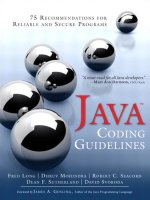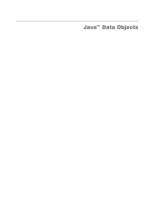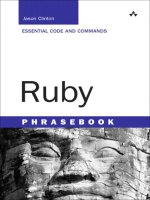Addison wesley XML schema complete reference sep 2002 ISBN 0672323745
Bạn đang xem bản rút gọn của tài liệu. Xem và tải ngay bản đầy đủ của tài liệu tại đây (1.59 MB, 464 trang )
26.1SystemArchitecture
Mostdistributedarchitecturesdiscussthreetiersinthe
developmentofWeb-basedapplications,buttheWebServer
tiershouldreallybethoughtofasaseparatelayer.Infact,as
wemovecloserandclosertoWebservicesthislayermightbe
replacedaltogether.Therefore,thelayersmodeledfortheCRSS
are:
Clienttier
WebServertier
Applicationtier
Databasetier
Let'slookateachtierandthetechnologiesusedtoday.The
ClienttiertypicallyconsistsofHTMLandJavaScriptfor
computersandWirelessMarkupLanguage(WML)forPDAs.Itis
possibletoembedmanyothercontrols(Shockwave,applets,
ActiveX),butwewillexcludetheseplug-intechnologiesfrom
ourapplication.
Thesimplestwaytomodeltheapplicationistostartwithhighlevelarchitecturaldiagramsandthenmodelthetiersoneata
time.
ThearchitectureshowninFigure26.1hasbeenusedinmany
applicationsforquiteafewyearsnow.Infact,thesuccessof
thisarchitecturehasacceleratedtheacceptanceandemergence
ofXMLstandards.
Figure26.1.n-Tierarchitecture.
YoumightwonderwhyXMLSchemaandtheotherXML
conceptsshouldbeintroducedtothemixillustratedinFigure
26.1.Wecertainlyhaveenoughacronymswithoutintroducing
alltheX-basedones.YoushouldnotstarttousealltheseX
technologieswithoutagoodjustification.Properlyjustifyingthe
useofXML-basedtechnologieswillseemsimpleifyouhave
alreadybeendealingwithsomeofthefollowingissues:
HTMLbrowsersdonotcomplywithrigidstandards.This
mightnotbeastunningrevelationtoanyWebdeveloper
whohasbeenupallnightsortingoutaNetscapeversus
InternetExplorerissue.UseXMLwithXSLTtoproducewellformedHTML—orbetteryet,XHTML.
TheWebServertierinFigure26.1hasmanycompeting
technologies.Learningallofthemisdifficult.Theyareall
tryingtodothesamething:acceptuserinputsasHTTP
messagesandformattheoutputresultsasHTMLorWML.
ManyapplicationshavemisusedtheWebserverlayerand
placedfartoomuchvalidationandbusinesslogicinit.
Maintainingtheseprojectsisextremelydifficult.The
technologiesaresimplifieddramaticallyifyouswitchto
XML-basedtechnologiesanduseXMLschemastoperform
thevalidation.
TheComponenttieriscertainlythemostinteresting.You
havethenever-endingdebateaboutJavaversusanything
else.Whatisfrequentlylostinthisdebateisthereal
purposeofthistier,whichistoprovidebusinesslogic.
Businesslogicisbasedondata,andXMListailor-madefor
manipulatingdata.ByusingXML,youcansimplifyyour
componentsbypassingXMLnodesbackandforth.Each
nodecanuseanXMLschemaforitstestcase.This
eliminatestheneedtowritesoftwaretotestsoftware—a
classicCatch-22.IfyouaskWebdevelopershowtheytest
anapplication,they'relikelytosaytheyopenNetscapeand
InternetExplorerandverifythattheapplicationworks.
Couldyouimaginetestinganewaircraftwingbyinstalling
itonaplaneandtakingitupforaflight?Ifitworksonce,
willitworkeverytime?Willitworkwithallrevisions?
Obviously,muchbettertestmethodologyisrequired.
TheDatabasetierisamovingtargetrightnow.Both
MicrosoftandOraclearerapidlyaddingXMLcapabilitiesto
theirdatabases.ThesecapabilitiesenableyoutouseXML
messagestorequestdatabaseactions,eliminatingallthe
formattingrequiredinanActiveServerPage/ActiveData
Object(ASP/ADO)solutionorcorrespondingJavaServer
Page/JavaDatabaseConnectivity(JSP/JDBC)scenario.
Note
MicrosoftandOraclearenottheonlyvendorsusingXMLintheir
databaseproducts.IBM,Informix,Sybase,andothersare
addingsimilarcapabilities.
OurCampusResourceandScheduleSystem(CRSS)casestudy
usesXMLasitsfoundation,whichisillustratedinFigure26.2.
WhencomparingFigure26.2toFigure26.1,themoststriking
differenceistherelianceonXMLacrossallthetiers.
Figure26.2.n-TierXMLarchitecture.
AsyoucanseefromFigure26.2,XMLtechnologiesdonot
replaceHTML,JavaScript,.NET,Java,orSQL.XMLsimplyis
usedbythesetechnologiestoincreasetheirreliabilityand
robustness.
InthemodelinFigure26.2,XMLschemasareusedintwo
ways:
Defininginterfacesbetweendifferentprocessesortiers
Validatingdata
Figure26.2showsthattheWebtierconvertsanincomingHTTP
requestintoanXMLmessage.Thismessageisvalidatedagainst
anXMLschema.Onceyouhavevaliduserinput,themessageis
senttotheComponenttierwherebusinesslogicisapplied.
DatabaseaccessisalsoaccomplishedwithXMLmessages.
Thechallengeatthedatabaseinterfaceisdifferentthanatthe
userinterface.Youcanensurethatyourcomponentsare
producingvalidXMLinthedesignofthecomponents,butyou
needtomapthedatafromanXMLsourcetoarelational
databaseformatandviceversa.XMLschemascanprovidethe
hierarchicaltorelationalmapping,asyouwillseeabitlater.
Interfacesbetweenallthreetiersaresimplifiedwhenusing
XML.TestingatallinterfacesisaccomplishedusingXML
schemas.Thisabilitytotesttheinterfacesdeclarativelyallows
softwareprojectstobeworkedonbyteamsmoreeasily.
YouwillbegintheCRSSapplicationbymodelingtheClienttier
totheWebServertier.Youwillmodeleachrequirementby
usingUMLsequencediagrams.Thenyouwillconverteachof
thesesequencediagramsintoXMLmessages.Thesemessages
definetheworkflowoftheapplication.
Let'sstartbymodelingthefollowingrequirement:Viewexisting
reservationsonaperresourcebasis.
Obviously,userinputwillberequired.Youneedtosupport
multipledevices,butlet'sstartbyassumingabrowser
interface.Asyouwillseelater,implementingthesupportfor
anyotherWeb-enableddeviceiseasy.Thesequencediagramin
Figure26.3modelsthefirstrequirement.
Figure26.3.ViewResourceReservationsequence
diagram.
YoucanseefromthesequencediagraminFigure26.3that
eachtierismodeledbyaninterface.ThereisaWebinterface
thatcanbeimplementedbyusingActiveServerPages(ASP),
JavaServerPages(JSP),CommonGatewayInterface(CGI),or
anyotherWeb-server-basedframework.TheWebinterface
doesnotdoanysignificantprocessing;itspurposeistosupport
userinteraction.Thisisexactlywhatyouintend.Keepthecode
inASPorJSPtoanabsoluteminimumtoincreasethe
maintainabilityofyourapplications.SimplyapplyinganXML
schemaprovidesuser-inputvalidation.Theparserwillthrow
anyvalidationerrorsintherepackagedXMLdata.
Youhaveenoughinformationatthispointtodecideonthe
contentsoftheXMLmessage.TheXMLmessageusedto
requesttheresourcecalendarviewisshowninListing26.1.
Listing26.1XMLMessagetoGetResourceCalendar
<?xmlversion="1.0"encoding="utf-8"?>
<getResourceCalendar>
<resourcename="bigBuilding">
endDay="16"/>
</resource>
</getResourceCalendar>
Asyoucansee,theprecedingcodeisasimpleXMLmessage
createdintheWebClienttier.YoucanuseanXMLschemato
validatethismessage.Theschemaprovidesthecontractyou
havewiththeinputdevice.Usingthismodelenablesusto
supportWeb-basedclientsorXML-enableddevices.Youcanuse
schemastoopenyourservicetotheInternetbycreatingaWeb
service.
Note
TheabilitytopublishschemasontheInternetsoyourservices
canbemadeavailabletoanyoneisthebasisforWebservices.
WebServicesDescriptionLanguage(WSDL)usesXMLschemas
andhasbeensubmittedasapossiblestandardtotheW3C.
WSDLusesXMLschemastodescribeyourapplicationinterfaces
andinterfacedefinitions.
YouneedtocreatetheXMLschemabyusingtheXMLmessage
createdinListing26.1.Youhaveseveralwaysyoucouldgo
aboutcreatingtheXMLschema.Therearequiteafewtoolsthat
doareasonablejob;however,notoolcanknowyourbusiness
applicationrequirements.Mosttoolsthatautomatically
generateXMLschemasproducesomethingsimilartothe
exampleinListing26.2,producedbyXMLSpy.
Listing26.2XMLSchemaforResourceCalendarMessage
<?xmlversion="1.0"encoding="UTF-8"?>
" />xmlns:xsd="
xmlns=
" />elementFormDefault="qualified"
attributeFormDefault="unqualified">
<xsd:elementname="getResourceCalendar">
<xsd:complexType>
<xsd:sequence>
<xsd:elementref="resource"/>
</xsd:sequence>
</xsd:complexType>
</xsd:element>
<xsd:elementname="range">
<xsd:complexType>
</xs:complexType>
</xsd:element>
<xsd:elementname="resource">
<xsd:complexType>
<xsd:sequence>
<xsd:elementref="range"/>
</xsd:sequence>
use="required"/>
</xsd:complexType>
</xsd:element>
</xsd:schema>
Nowyouhaveaschematovalidateyourinputmessage
against.Youcantestthisschemabyusingaplug-in
(forInternetExplorer
thatletsyousimplyright-clickonafileandselectValidate.You
couldalsouseanyvalidatingXMLparserforthisoperation.
Beforeyoucandoanytesting,however,youhavetoassociate
theXMLsourcewithitscorrespondingschema.Youcandothat
asshowninListing26.3.
Listing26.3SchemaReferenceAddedtoGetResource
CalendarMessage
<?xmlversion="1.0"encoding="utf-8"?>
" />xmlns:xsi="
xsi:schemaLocation=
" /><resourcename="bigBuilding">
</resource>
</getResourceCalendar>
Notethecustomnamespaceonthethirdline.Thisisagood
practicebecausenamespacesprovidescopetoXMLdocuments.
Listing26.2definedthenamespace,andyouuseitwithinXML
documentsthatwillbevalidatedbyschemaswiththesame
namespace.Moreinformationonnamespacescanbefoundin
Chapter3.
TestingtheXMLschemaisverystraightforward.Youcanuse
anyvalidatingparsertoloadthedocument.Ifthedocument
loadswithnoerrors,theXMLmessageisvalidrelativetothe
XMLschema.Naturallywemustmaketheassumptionthatthe
validatingparserdoesnothaveerrors.Therearemanytools
youcanusetoprovidevalidation.Someofthepopulartoolsare
XMLSpybyAltova()
Xerces( />.NETfromMicrosoft( />IBM'sparsers()
Whenjustdoingquicktests,theInternetExplorerplug-inis
convenient.Microsofthasadownloadcallediexmltls.exe
thatcanbefoundbyfollowingthelinksatthe
site.Afterinstallingiexmltls.exe
youcanjustaddthereferencetoourXMLschemaintotheXML
documentandthenopentheXMLdocumentinInternet
Explorer.Right-clickingwithinthedocumentinInternetExplorer
providesamenuitemtovalidate.Let'stestourdocumentusing
thistestrightnow.
PerformingvalidationtestsusingInternetExplorer'splug-inis
simple,asshowninFigure26.4below.Youcanseethatthe
documentisvalid.YoucanmakechangestotheXMLandverify
thattheXMLschemafunctionsasexpected.Youshouldtestall
thepermutationspossible,sofeelfreetoexperiment.
Figure26.4.Validationtest.
Tip
TheSchemaRecommendationisveryrecentandsomeareas
canbeinterpretedindifferentways.Whentestingyour
schemas,youshouldusethevalidatingparserthatwillbeused
inyourproductionenvironment.Testbyusingseveralvalidating
parserstoensurethattheschemadesignisrobust.Checkat
www.w3.orgforadditionaltoolsthattestXMLschema
compliance.
26.1.1ClientTierModelRevisited
TechnicallythereiscertainlynothingwrongwiththeXML
schemageneratedinListing26.2.Infact,thetoolsdoagreat
jobofgettingyoustarted.Unfortunately,that'stoooftenasfar
asanyonegetswiththeXMLschemadesign.ForXMLschemas
toproviderealpowertoyourprojects,youneedtotakeastep
backandthinkaboutallthedatatypesyourclientapplicationis
likelytosend.Youshouldthencreatesimpledatatypesand
includethemasneededtocreateflexibleXMLschemas.This
wayyoubuildsmall,easilytestedelementsandtheir
correspondingschemasandthenaggregatethemasneeded
intoagoverningdocumentschemaonaperdocumentbasis.
Thefollowingsectionshowshowto
Identifyreusabledatatypes
CreatemodularXMLschemas
Testmodularschemas
AggregatethemodulesintoamasterXMLschematoallow
resourcereservations
26.1.1.1XMLSchemaSupportforReusable
Datatypes
Obviouslythequestionishowtomodularizeyourschemasto
provideamoreproductionworthysolution.Fortunately,the
SchemaRecommendationprovidestechniquestoachievethis
modularity.Thethreetechniquesare
include:Usedtoincludeotherschemadocumentsthat
havethesametargetnamespace.
import:Usedtorefertocomponentsfromother
namespaces.
redefine:Similartoincludewiththeadditionaloption
thatyoucanprovidenewdefinitionsforsomeorallofthe
typesintheredefinedschemadocument.
Belowisanexampleoftheincludeelement:
<xsd:includeschemaLocation="mySchemaModule.xsd"/>
Sometimesyouneedtooverrideanelementdefinitioninan
includedschema.Inobjectoriented(OO)programming
environments,youwouldsimplyinheritfromthebaseclassand
overridethebaseclass'simplementationofaspecificmethod.
XMLschemasborrowfromthispopularapproachthroughthe
useofredefineelements.Listing26.4demonstratestheuse
ofredefine.Redefiningschemasisusefulwhenyouare
includinglargelibrariesandneedtochangeoneortwotypes.
Inmanycasesyouwillfinditmoreusefultojustalterthe
schemaratherthanusingredefine.
Listing26.4RedefiningtherangeTypeSimpleType
<xsd:redefineschemaLocation="mySchemaModule.xsd">
<xsd:simpleTypename="rangeType">
<xsd:restrictionbase="xsd:string">
<xsd:maxLength="30"/>
</xsd:restriction>
</xsd:simpleType>
</xsd:redefine>
26.1.1.2IdentifyingReusableDatatypes
YouknowhowXMLSchemaletsyoureuseandredefine
datatypes.Nowyouneedtodeterminewhatreusablesimple
typesyouneed.ModelingeachmessagebyusingtheUML
techniquesdiscussedinthischapteridentifiesyourapplication's
requireddatatypes.Thecompletedesignprocessesrequiredto
properlymodeltheapplicationarebeyondthescopeofthis
book;however,wedoreviewthesequencediagramyouwilluse
tocreatetheXMLschema.
YouusethedesiredreservationrequestXMLmessageto
identifythedatatypesyouwouldliketocreate.Thisapproach
letsusfocusontheXMLSchematechniquesandillustratehow
tocreatereusableXMLschemas.Typically,youstartwiththe
UMLsequencediagramandthencreateasampleXMLmessage
representingthedatarequiredtoaccomplishthetask.The
sequencediagramforreservingaresourceisshowninFigure
26.5.
Figure26.5.CRSSReservationRequestSequence
diagram.
Inarealsystem,thesequencediagramwouldhavefarmore
complexity.ForourCRSSapplication,asimplediagram
illustrateshowthediagramscanassistincreatingXML
schemas.
UsingthesequencediagraminFigure26.5,youcancreatea
sampleXMLmessagethatassistsindeterminingthedata
requiredtosatisfytherequest.ThesampleisinListing26.5.
Listing26.5ReservationRequestXMLMessage
<?xmlversion="1.0"encoding="utf-8"?>
<reservation_request>
start_time="22:30:00"
duration="5"
description="Varsitybasketballpractice"
configuration="basketball"/>
<security>
email=""
type="coach"/>
</security>
<roomname="Gymnasium"capacity="100">
type="administration"/>
</room>
</building>
<workflow>
<requestview="xslt/request.xslt"status="false"/>
</workflow>
</reservation_request>
ThereservationrequestshowninFigure26.5canbebroken
downintoseveralimportantsteps.Thereservationelement
containstheinformationauserisgoingtoprovidebyusinga
browserorsomeotherWebinterfacedevice.The'security'
elementisusedtoattachsecurityinformationtotheincoming
message.Theworkflowelementisusedtotrackthestatusof
thereservationrequest.Thebuildingelementcontains
responsedatathatwillbesenttotheuserwithroomcapacity
information,requiredforms,theroom'scontactpersonand
more.Theapplicationwillfillintheuser'ssecurityinformation,
supplytheuserwiththerequiredformstofillin,andkeeptrack
oftheuser'sstatusincompletingtheworkflow.
Let'susethemessageinListing26.6tocreateamatrixof
datatypesandtheconstraintswewouldliketoapply.The
matrixinformationinTable26.1isareasonablestart.
Table26.1.DatatypesandRequiredConstraints
Item ElementType
1
reservation
2
3
4
AttributeType
Base
Datatype
DesiredConstraints
building
string
Enumeratedlistofpossiblebuildings
room
string
Applyaminandmaxsize
start_date
date
Constrainvaluetoavaliddate
format
start_time
time
Constrainvaluetoavalidtime
format
5
6
7
requestor
8
9
10
11
building
12
13
room
14
duration
int
Valuebetween1and23hours
inclusive
configuration string
Enumeratedlistofroom
configurations
first
string
Applyaminandmaxsize(2,24)
last
string
Applyaminandmaxsize(2,24)
string
Constraintoe-mailW3C
Recommendations
type
string
Enumeratedlist
id
int
Numberassignedtoeachbuilding
location
anyURI
ConstraintoW3CspecsforURLs
name
string
Sameruleasreservation\room
capacity
int
ConstrainwithminInclusiveand
maxInclusive
15
request
status
boolean
EnumeratedvalueequaltoTRUEor
FALSE
16
approval
status
boolean
Sameasline15
17
viewCalendar status
boolean
Sameasline15
18
viewPending
boolean
Sameasline15
status
YoucanseeinTable26.1thateachXMLmessagehasanumber
ofdatatypesanddesiredconstraints.Severalofthesedatatypes
willbeveryreusableonmanymessages.Specifically,
constraintsonuser'snames,e-mailformatting,date,time,and
statuswillbeusableacrossmanyXMLschemas.Youalways
wanttoachievethehighestreusableratefromyourwork.
DevelopingmanysmallXMLschemasthatcanbetested
independentlyandthenincludedinyourprojectwillhelp
achievethegoalofreusability.
26.1.1.3CreatingXMLSchemaReusable
Datatypes
Youshouldidentifythedatatypesyouthinkwillbereusablein
thisandfutureapplicationsfromthoseinTable26.1.Many
datatypescanbereusedfrequently.
StartbycreatinganXMLSchemasimpletypetomodel
start_date.TheSchemaRecommendationhasadate
datatypeasoneoftheprimitivedatatypes.TheCRSS
applicationneedstoberestrictedtoallowreservationrequests
tobeplacedonlybetween2001and2099.Inaproduction
applicationyoumightnotwanttocreateaY2.1Kproblem,but
youwillintheCRSSapplicationtodemonstrateXMLSchema
restrictions.
Creatingasimpletypetoconstraintheattributedatecanbe
doneasshowninFigure26.2.Noticethatapatternisusedto
constrainthevaluerangeandtheformatthatthedatemustbe
submittedin.Ifyoujustneededtoconstrainthevaluesto
range,theminInclusiveandmaxInclusiveconstraints
couldhavebeenapplied.
Listing26.6CRSSStartDateConstrained
<?xmlversion="1.0"encoding="utf-8"?>
<xsd:annotation>
<xsd:documentation>
FormatdaterangetoCCYY-MM-DDw/range2001_to200
</xsd:documentation>
</xsd:annotation>
<xsd:simpleTypename="dateType">
<xsd:restrictionbase="xsd:date">
</xsd:restriction>
</xsd:simpleType>
</xsd:schema>
DocumentingyourXMLschemasisalwaysagoodidea.The
restrictionelementspecifiesthatthebasedatatypeyouwill
derivefromistheXMLSchemadate.Thenextlinederivesa
newdatetypebyaddingadditionalrestrictions.Youhave
chosentonamethenewlyderivedtype'dateType'.Thenew
dateTypedatatypehasallthepropertiesoftheXMLSchema
datedatatypeandouradditionalrestrictions.
ThepatternvaluemustbeanXMLSchemaregular
expression.Formoreinformation,refertoChapter14.
Nowthatyouhavecreatedasimpledatatype,dateType,the
questionishowtotestit.Onetechniqueistocreateanother
XMLschemawithaverysimplestructureandjustusetheXML
Schemaincludeelementtoreferencethedatatypeyouhave
created.InthetestcaseinListing26.7,atestXMLschemais
createdthathasarootelementnamedrootwithone
additionalelementcalledtest.Thetestelementtakesone
attribute,dateTest,whichusesournewdateType.Listing
26.7isthetestcase.
Listing26.7SchemaforTestingdateType
1.<?xmlversion="1.0"encoding="utf-8"?>
2.
4.examples/CRSS/dateTypeTest.xsd"
5.xmlns="
6.examples/CRSS/dateTypeTest.xsd"
7.xmlns:xsd="
8.<xsd:includeschemaLocation="dateType.xsd"/>
9.<xsd:elementname="root">
<xsd:complexType>
<xsd:sequenceminOccurs="1"maxOccurs="1">
<xsd:elementname="test">
<xsd:complexType>
</xsd:complexType>
</xsd:element>
</xsd:sequence>
</xsd:complexType>
</xsd:element>
</xsd:schema>
TheincludeelementinListing26.7includesournew
dateTypesimpletype.ThedateTestattributeusesthe
customdatatypethatyoudefined.Youneedtotestthisby
creatingaXMLdocumentthatadherestotheXMLschemain
Listing26.7andthenvalidatingbyusingoneofanynumberof
tools.Forourpurposes,useMicrosoft's.NETFrameworkto
performthetest.IfyoudonothaveVisualStudio.NETthen
usethevalidationplug-inforInternetExplorermentioned
earlier.
UseanytexteditortocreatethecodeshowninListing26.8.
ThislistingreferencesthedateTypeTestschemathatincludes
thedateTypesimpletypecreatedfirst.Thisprovidesavery
simpletesttoverifythatthesimpletypeiscorrect.
Listing26.8XMLTestCasefordateTypeSimpleType
1.<?xmlversion="1.0"encoding="utf-8"?>
2.<rootxmlns=" />3.<testdateTest="2001-02-26"/>
4.</root>
YoucanexperimentwiththeXMLdocumentinListing26.8and
verifythatyournewdateTypeXMLschemaisworking.
ChangingthedateTestattributeinListing26.8to2000-02-26
resultsinanerrorinthe.NETFramework,asshowninFigure
26.6.
Figure26.6.Failedvalidationresult.
Testingtheschemain.NETissimple.Addthelistingsshownin
Listings26.6,26.7,and26.8.Next,openthefilecontaining
Listing26.8.ThenopentheXMLmenuandchooseValidate.
Notethestatusmessagesdisplayedintheoutputpaneofthe
.NETwindows.
Justtobethorough,alsotestthedateTypebyusingXMLSpy.
WithXMLSpy,youcanusewhatevervalidatingparseryou
prefer.UsingXMLSpy,simplyloadyourXMLdocumentand
assignthedesiredschematovalidatewith.XMLSpydisplays
errorsifyourXMLsourceviolatesthegoverningschema'srules,
asshowninFigure26.7.
Figure26.7.FailedvalidationresultwhenusingXMLSpy.
ThefailedresultinFigure26.7isnotduetotheXMLschema
dateformat.The2000-12-31formatworkswellwiththeXML
schemaprimitivedatedatatype.Thepatternyouused
constrainedthedaterangetotheyears2001through2099.
ProperlyrestrictingyourdatatypesbyusingXMLSchemafacets
reducestheamountofvalidationcodetypicallyrequiredbythe
application.
Note
InadditiontoChapter14,agoodsourceforregularexpressions
isBewarethatXMLSchemaregular
expressionsarenotthesameasPerlregularexpressions.A
goodplacetotestregularexpressionsforcompliancewiththe
XMLSchemaversionisDanielPotter'ssiteat
ThissitefeaturesaJava
appletthatcanbeusedtotestyourSchemapatternsonline
interactively.
26.1.1.4ReusableDatatypeReview
Thisisagoodpointtoreviewwhatwe'vedonesofarin
creatingreusabledatatypes.Theprocessisoutlinedbelow:
1. CreateaUMLsequencediagramforaspecificaction.
UsethesequencediagramtocreateasampleXMLmessage.
Determinethedatatypesrequiredtofulfilltheaction
modeledbythesequencediagram.
Identifythereusabledatatypes.
CreateaseparateXMLschemawiththeproperrestrictions
foreachreusabledatatype.
TesteachXMLschemamodule.
AggregateyourtestedXMLschemamodulesintoamaster
fortheactionmodeledbyyoursequencediagram.
TherearemanydifferentwaystorestrictdatabyusingXML
schemas.Youhaveseenseveralexamplesinpreviouschapters
ofthebook.TheCRSSapplicationXMLschemasrestrictthe
databyusingmanyXMLSchematechniques,includingthe
following:
pattern:Entriesmustmatchthepatternspecified
minOccurs:Minimumnumberofrepetitionsallowed
maxOccurs:Maximumnumberofrepetitionsallowed
minLength:Minimumstringlength
enumeration:Listofallowedentries
minInclusive:Minimumintegervalueallowed
maxInclusive:Maximumintegervalueallowed
EachXMLsimpletypewillnotbereviewedindetail.Thefinal
codelistingforourreservationrequestisinListing26.9.Listing
26.9canbeappliedtoListing26.7toprovidevalidationtothe
completedreservationrequest.
Listing26.9XMLSchemaforCompletedReservation
Request
<?xmlversion="1.0"encoding="utf-8"?>
"
xmlns="
xmlns:xsd="
<xsd:includeschemaLocation="dateType.xsd"/>
<xsd:includeschemaLocation="buildingType.xsd"/>
<xsd:includeschemaLocation="roomType.xsd"/>
<xsd:includeschemaLocation="configType.xsd"/>
<xsd:includeschemaLocation="durationType.xsd"/>
<xsd:includeschemaLocation="emailType.xsd"/>
<xsd:includeschemaLocation="requestorType.xsd"/>
<xsd:includeschemaLocation="locationType.xsd"/>
<xsd:includeschemaLocation="nameType.xsd"/>
<xsd:includeschemaLocation="urlFormType.xsd"/>
<xsd:elementname="reservation_request">
<xsd:complexType>
<xsd:sequenceminOccurs="1"maxOccurs="1">
<xsd:complexType>
type="dateType"/>
type="xs:time"/>
type="durationType"/>
type="xs:string"/>
type="configType"/>
</xsd:complexType>
</xsd:element>
<xsd:elementname="security">
<xsd:complexType>
<xsd:sequenceminOccurs="1"maxOccurs="1">









